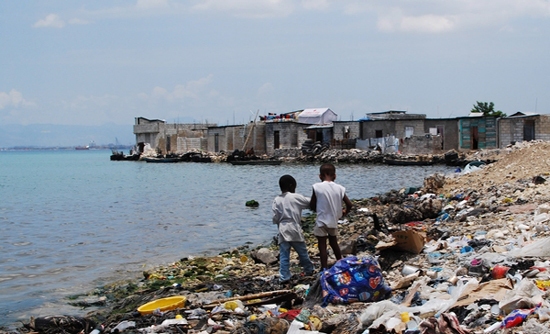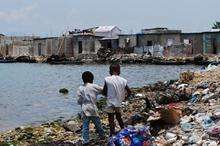Two years since the beginning of the epidemic, cholera remains a major threat in Haiti, where little has been done to improve the conditions that enable the continued spread of the disease.

Haiti 2012 © Mathieu Fortoul/MSF
Due to living conditions for earthquake survivors and the general population that help enable the spread of cholera in Haiti, the disease remains a lethal threat two years after the epidemic first appeared in the county.
It’s been two years since a cholera epidemic first swept through Haiti, infecting hundreds of thousands of people who’d never before encountered the disease. It was clear that cholera was likely to be a recurring issue in Haiti, but even today, new patients cannot be certain that they will get the treatment they need, and little has been done to improve the environmental conditions that enable the continued spread of the disease.
In Port-au-Prince, more than 350,000 survivors of the 2010 earthquake are still being housed in camps. Tens of thousands more are living in shantytowns, where sanitary conditions remain deplorable, preventing the population from implementing the health measures necessary to protect themselves. “We’re living under difficult conditions, with no access to clean water and soap,” said a man named Wilsème, who has been living in a camp now for almost three years. “We know that we are at risk of being infected with cholera, but we don’t have any of the means we need to protect ourselves from the disease.”
Since the start of the year, Doctors Without Borders/Médecins Sans Frontières (MSF) has treated 12,000 cholera patients in five cholera treatment centers (CTCs) in Port-au-Prince and Léogâne, a town some 30 kilometers [18 miles] west of the capital. “This is a drop in the numbers, compared with the approximately 35,000 cases that we admitted during the same period in 2011 in Port-au-Prince,” indicated Oliver Schulz, MSF’s head of mission in Haiti. “We continue to see an average of 250 new cases each week in our facilities, but this is still a high number,” he worries.
The overall response, however, has been limited because reduced international funding has hampered the delivery of medical care and the provision of clean water and sanitation services. “This year, MSF had to keep most of our CTCs open throughout the year because cholera is far from being controlled,” said Schulz. “The measures to prevent and treat cholera are still not enough.” The response capability of the Ministry of Health remains extremely low as well. As a result, during the most recent spike of new cases this past May, MSF treated more than 70 percent of the total number of patients registered in Port-au-Prince. Wilsème was one of these cases. He was hospitalized on an emergency basis: “I went to the public hospital, but they told me that they couldn’t treat me and I was sent to an MSF treatment center, where I received care.”
If cholera’s ongoing spread and potency are going to be contained, significant improvements in the areas of water and sanitation are necessary. “This will take time, and this is why medical care for cholera patients remains a key challenge that the Haitian authorities need to address right now,” Schulz explained. Cholera is a disease that is easily treated, but it is crucial that specific treatment centers are made accessible—particularly in Haitian health care facilities—and that patients are brought to them as soon as possible after the first symptoms appear. Without adequate treatment, the disease can kill a person within a few hours.
Accordingly, MSF remains mobilized to support the Haitian health authorities during the peak periods and to provide technical and logistical support, particularly as it pertains to integrating cholera treatment in health care facilities.
Since the cholera epidemic began in October 2010, the disease has infected approximately 600,000 people in Haiti (counting known cases only, though even that number amounts to roughly 6 percent of the country’s entire population) and has killed more than 7,500 people. As soon as the first cases were confirmed in 2010, MSF began offering treatment. Between October 2010 and November 2011, MSF had more than 75 CTCs scattered throughout Haiti, and 4,000 Haitian staff and 400 international staff were mobilized to treat more than 160,000 patients.




